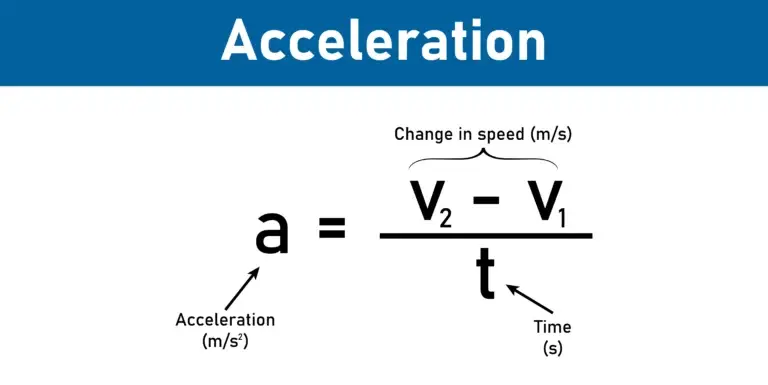What is Acceleration?
Acceleration is a key concept in physics, representing the rate at which an object’s velocity changes over time. It is a vector quantity, which means it has both a magnitude and a direction:
Acceleration is the rate of change of velocity of an object with respect to time. It indicates how quickly an object speeds up, slows down, or changes direction. Mathematically, acceleration (a) is expressed as the change in velocity (Δv) divided by the time interval (Δt) during which the change occurs:
\Large a=\frac{\Delta v}{\Delta t}
The International System of Units (SI) measures acceleration in meters per second squared (m/s²). This unit indicates that for every second, the object’s velocity changes by a certain number of meters per second.
Acceleration is not only about an increase in speed; any change in the velocity of an object, including decreases in speed (deceleration) and changes in direction (such as turning a corner), constitutes acceleration. The direction of the acceleration vector is the same as the direction of the change in velocity but not necessarily the same as the direction of the movement itself. For example, when a car slows down, its acceleration is in the opposite direction to its motion.
Acceleration

Table of Contents
Types of Acceleration
Linear
This occurs when the velocity’s rate of change occurs along a straight path. The direction of motion remains constant in linear acceleration, but the speed can change. When the object’s speed increases, it is positive, and negative acceleration or deceleration occurs when the speed decreases. When an object moves at a constant speed in a straight line, it has zero linear acceleration.
Tangential
During circular or rotational motion, tangential acceleration refers to the rate of change of linear speed of an object along the circumference of the circle. It is always directed tangentially to the circular path and affects the speed of the object moving along the curve but not its direction of travel. This type of acceleration is what one would experience when speeding up or slowing down while traveling around a circular track.
Radial
Also known as centripetal acceleration, it is directed toward the center of the circular path. It is responsible for the change in direction of the velocity of an object in circular motion, not its speed. Radial acceleration ensures that the object continues to move in a circular path and is perpendicular to the tangential acceleration. This inward acceleration keeps an object moving in a circle, like a car turning around a curve or the Earth orbiting the Sun.
Acceleration in Physics
Calculation
The calculation involves determining the rate at which the velocity of an object changes over time. When an object’s velocity changes at a constant rate, the formula to calculate acceleration (a) becomes straightforward:
\Large a=\frac{\Delta v}{\Delta t}
where:
- \Delta v is the change in velocity, calculated as the final velocity (v_f) minus the initial velocity (v_i),
- \Delta t is the time interval over which the change in velocity occurs.
Additionally, this can be expressed as:
\Large a=\frac{v_f – v_i}{\Delta t}
This formula signifies that acceleration is the quotient of the velocity change and the time over which this change happens.
- If v_f is greater than v_i, the acceleration is positive, indicating an increase in speed.
- If v_f is less than v_i, the acceleration is negative, indicating a decrease in speed or deceleration.
- If the direction of velocity changes, regardless of the speed, the object is also accelerating as it involves a change in velocity
Acceleration and Force
According to Newton’s second law of motion, a direct relationship exists between the force applied to an object, its mass, and the acceleration it experiences. The law states that the acceleration of an object is directly proportional to the net force acting upon it and inversely proportional to its mass. This relationship can be mathematically represented as:
where:
- F is the net force applied to the object,
- m is the mass of the object, and
- a is the acceleration of the object.
This equation implies that an object with a larger mass will experience a smaller acceleration for a given force. Conversely, more force is required for a more massive object to achieve a specific acceleration than a less massive one.
Graphing Acceleration
In a velocity-time graph, acceleration is represented by the slope of the graphed line. This graphical representation provides a visual interpretation of how an object’s velocity changes over time:
Positive Slope: When the velocity-time graph shows a line with a positive slope (rising from left to right), it indicates positive acceleration. This means the object is speeding up over time. The steeper the slope, the greater the acceleration.
Negative Slope: A line with a negative slope (falling from left to right) on the velocity-time graph signifies negative acceleration or deceleration. This indicates that the object is slowing down. The steeper the negative slope, the more rapid the deceleration.
Horizontal Line: If the velocity-time graph displays a horizontal line, the slope is zero, indicating no velocity change over time. This implies constant velocity and, therefore, zero acceleration.
Graphically, these different slopes provide immediate insight into the dynamic behavior of the object in motion, illustrating periods of acceleration, deceleration, and constant motion.
Acceleration Calculator
Instructions: Input the starting velocity, final velocity, and the change in time to calculate the acceleration.
Related Links
Velocity
Speed
Force
Inertia